 This coverage is made possible through the generous support of Marty and Kathy Hall and A Hall Mark of Excellence Award. To learn more about A Hall Mark of Excellence Award, or to learn how you can support FasterSkier’s coverage, please contact info@fasterskier.com.
This coverage is made possible through the generous support of Marty and Kathy Hall and A Hall Mark of Excellence Award. To learn more about A Hall Mark of Excellence Award, or to learn how you can support FasterSkier’s coverage, please contact info@fasterskier.com.
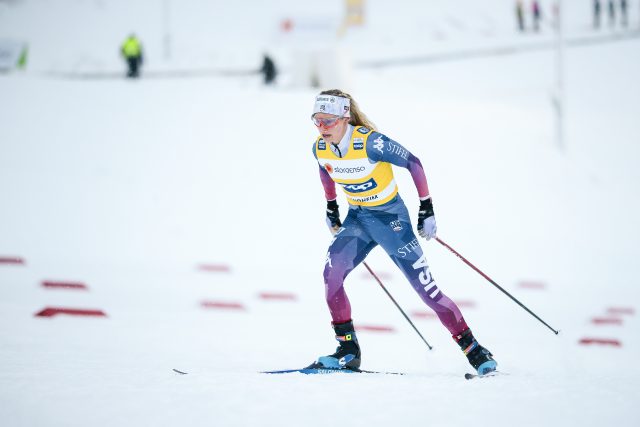
On Friday, the FIS World Cup moved on to Trondheim, Norway for the first Freestyle Sprints of the season. At the start of the day, America sat 1-2 in the World Cup overall rankings with Jessie Diggins in the lead and Rosie Brennan holding a one point advantage over Emma Ribom (SWE) for second. Ribom has won both sprint races held this year—both in the Classic technique— and would be looking to use her Sprint prowess to overtake Brennan. It was still an open question how Ribom would perform in a Freestyle-discipline sprint. Kristine Stavaas Skistad (NOR) would also be in the mix as she has proven herself to be a consistent Sprint contender; she has six Sprint podiums in a row. Still absent from the tour is last year’s overall crystal globe winner Tirul Udnes Weng (NOR).
After all of the action was over, it was Skistad taking the win in dramatic fashion in front of a loud and jubilant Norwegian crowd. Linn Svahn (SWE) finished second, with Ribom coming in third.
Diggins was the top American finisher in fourth place. Julia Kern was the next best American, taking ninth. Other American finishers were Rosie Brennan 18th, Alayna Sonnesyn 39th, and Novie McCabe 43rd. Lauren Jortberg was scheduled to race, but did not start due to illness.
The top Canadian was Amelia Wells in 51st.
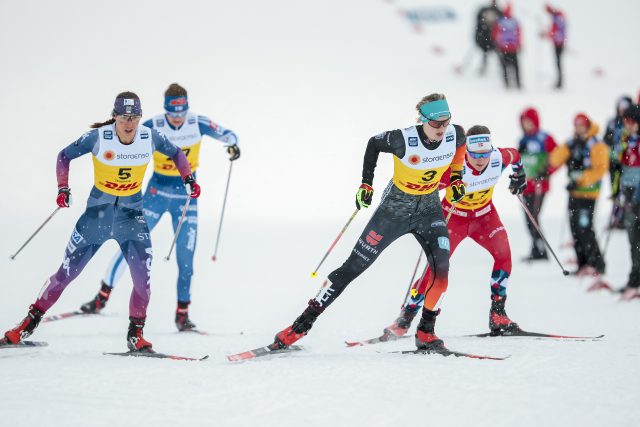
Women’s Freestyle Sprint
In the first quarterfinal heat, the second overall qualifier Jasmi Joensuu (FIN) would face the unenviable task of trying to hold off Ribom and Skistad. It proved too great a challenge for Joensuu, as Ribom and Skistad finished first and second. Joensuu finished fourth and would not advance beyond the quartefinal.
Svahn advanced out of the second quarterfinal in her continued ascent back to the top of the sprint standings after two seasons of injury and disappointment.
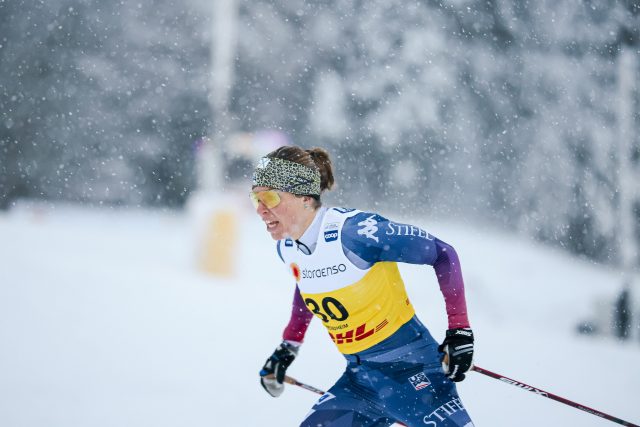
The third quarterfinal featured Rosie Brennan in a duel against Maja Dahlqvist (SWE), Mathilde Myhrvold (NOR), and Sofie Krehl (GER) who was the fastest qualifier of the group. Brennan went out hard, but quickly found herself forced to the outside of the first turn, but still able to maintain third position. Brennan was able to keep the pace up for the first uphill and moved to the front. She kept the lead into the stadium where Dahlquist passed her. Brennan fought to hold off Myhrvold and Kertuu Niskanen (FIN) but she ended up in a photo-finish with Niskanen and Myhrvold. Once the photo was analyzed, it was shown that Brennan had just missed out, finishing fourth. She would be done for the day. Her time wasn’t fast enough for a lucky loser. She missed advancing by only 0.03 seconds.
Diggins was in the fourth quarterfinal. She started off fast, a tactic she would repeat throughout the day. Leading up the first hill, she quickly opened a bit of a gap on Ane Appelkvist Stenseth (NOR). Diggins maintained a torrid pace up the course’s biggest uphill. Her strategy was clear; she wanted to go to the front and wear down the pack. She maintained her lead going into the course’s long downhill close to the finish. It was there that Diggins used her un-matched descending abilities to gap the field. She comfortably won the heat ahead of Frida Karlsson (SWE) in second.
Julia Kern (USA) landed in the fifth quarter final alongside Victoria Carl (GER) who had qualified third. Carl went straight to the front, using the same strategy the crowd had seen Diggins employ. She went out very hard, and quickly established a gap. But Kern was able to stay within striking distance and closed the gap on the first uphill. Carl kept up a brutal pace and had a hefty lead coming into the stadium. Kern put on a very strong finishing burst to finish second and beat out Lotta Udnes Weng (NOR).
After the quarterfinals were done, there were two Americans moving on: Diggins and Kern.
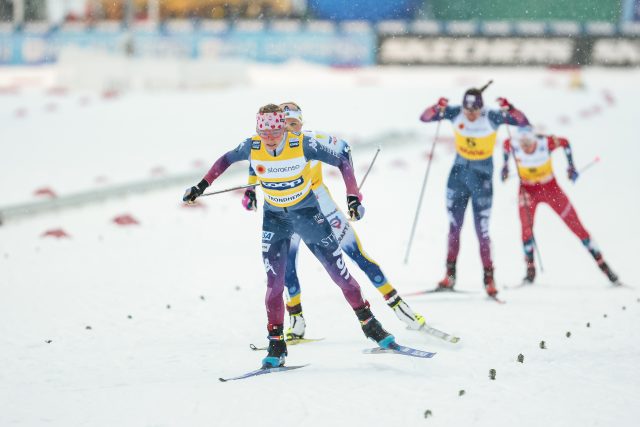
Sprint Semifinals
The first semifinal saw the fastest qualifier—Svahn—facing Ribom, Dahlqvist, Nadine Faehndrich (SUI), Skistad, and Jasmin Kahara (FIN). Kahara fell early in the race and would not be a factor. There wasn’t much separation of the pack throughout the race as they ascended the big climb going toward the finish. It was Svahn who was able to push to the lead along with Ribom. The two Swedes then set the pace at the front on the long downhill leading to the finishing stretch.
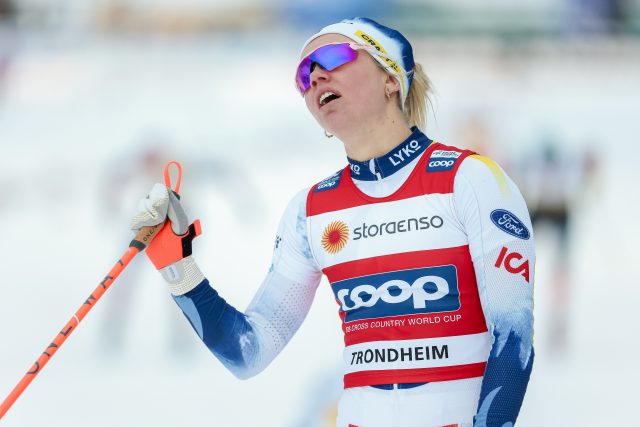
It was a fight all the way to the finish with a three way photo-finish between Svahn, Ribom and Skistad. After the photo was analyzed, it was Ribom and Svahn first and second. Skistad finished third, only .03 seconds out of first. She would be forced to wait to see if she advanced. Ultimately, Skistad advanced as a lucky loser.
Both American qualifiers were in the second semifinal along with Carl, Myhrvold, Karlsson, and Lotta Weng. In that race, Diggins quickly went to the front but was not able to create the same separation as she had in the quarterfinal. Kern was quickly pushed back to fifth.
Diggins continued to push the pace as Karlsson tried to hang with her, staying on Diggins’ ski tails. The rest of the field was able to close the gap as they entered the final downhill; there, Diggins was again able to use her descending skills to string out the field. Diggins pushed to the lead coming into the stadium along with Carl who was right with her. Carl pressed Diggins hard, but the American was able to hold off Carl. They would advance along with Weng.
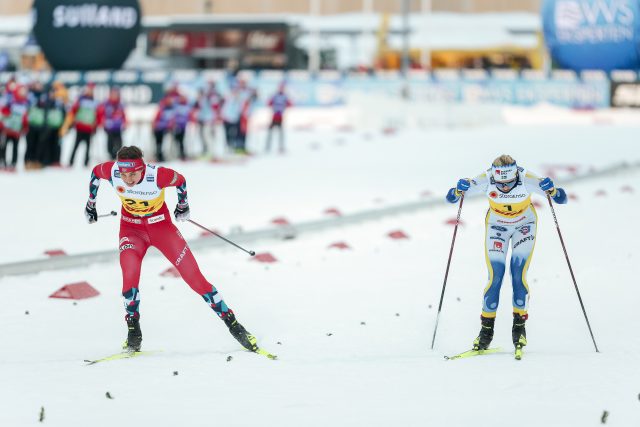
The Finals
The finals featured Diggins along with Ribom, Svahn, Carl, Weng, and Skistad. At the start, Skistad went to the front with Diggins forced out wide to the side, but Diggins quickly went by Skistad and worked her way to the front again. Her strategy was the same as it had been all day: go out hard and try to wear everyone down. But this time other skiers were able to hang with her. Ribom, Svahn, and Skistad were able to find another gear. In an impressive display of power, they established a gap over the other skiers with Diggins moving down to fourth.
Coming into the stadium it was Svahn in the lead with Skistad charging hard. At the finish it was another three-way photo finish, this time between Svahn, Skistad, and Ribom. After the review it was Skistad with the win, Svahn finishing second, Ribom taking third. Diggins ended up fourth.
After the race Diggins was asked if her strategy throughout the day was to go out hard and break up the field. She replied, “yes, in some ways.” She continued that, “I know my fitness is in a very good place, so I knew I could trust that to try and get myself into the final. It definitely is expensive in that you end up a little more tired for the final, but you are more likely to get into the final.” The conditions also played a factor, Diggins said, “I figured it would be very hard to pass; there’s mostly just one skied in track through all that slow new snow. So I figured I needed to be out in front.”
For her part, Brennan wasn’t pleased with today’s outcome. “I’m not very happy with my race,” she said. “I don’t think it was my best showing by any means. I felt I was skiing well and just really botched the finish. I don’t have any excuse for that. I’m mad at myself for not having good enough fight to the end; sometimes that’s hard to swallow.”
Today’s conditions presented a new challenge for racers and ski technicians. Today was the first race of the World Cup season in warm moist weather under the new fluoro free policy. Brennan didn’t seem to think it made much difference. “It was a little warmer today with falling snow,” she said. “I don’t think [wax] was the issue. As we move into the weekend and it turns to rain and very warm temperatures maybe we’ll notice more of a difference.”
Team USA coach, Chris Grover, thought the warm conditions were handled well. “It wasn’t super warm. There was cold snowpack underneath,” he said. “But it was new waxes and new structures for the [wax techs] in the truck. We’re going to really see it tomorrow when it’s supposed to dump rain.”
Diggins said she really didn’t notice a difference without fluoros, “but it’s hard to notice a difference unless you have a direct comparison. I honestly haven’t noticed any change. It’s fair; it’s even for everyone.”
Grover described the unique challenges of preparing skis for today’s conditions. “Yesterday, it was still quite cold, all the sudden this was the first morning of a change,” Grover observed. “So a lot of the testing was reserved for this morning, so there was a flurry of waxing this morning, and for a skate race you only get one pair of skis. One of the hardest things is getting up and getting going that much earlier. It makes for a really tough schedule.”

Today’s venue is the same location as next year’s World Championship. It’s a scouting opportunity for racers. “The three courses that we’re racing [this weekend] are the exact courses we’re going to race at the World Championships,” said Grover. “We’re going to get a great feel for it. Athletes came away from today’s Sprint course saying that it’s a really fair course, because it’s so wide. Today’s new snow did change the tactics a little and made passing on the outside difficult.”
For Norway, it was a dramatic finish on home soil, and the local crowd was definitely pleased.
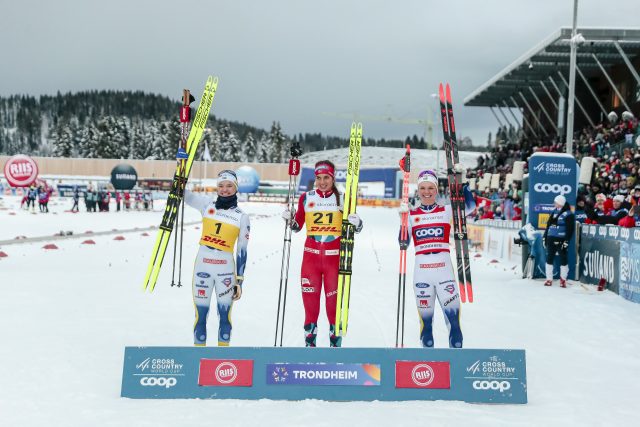
Women’s Freestyle Sprint RESULTS



